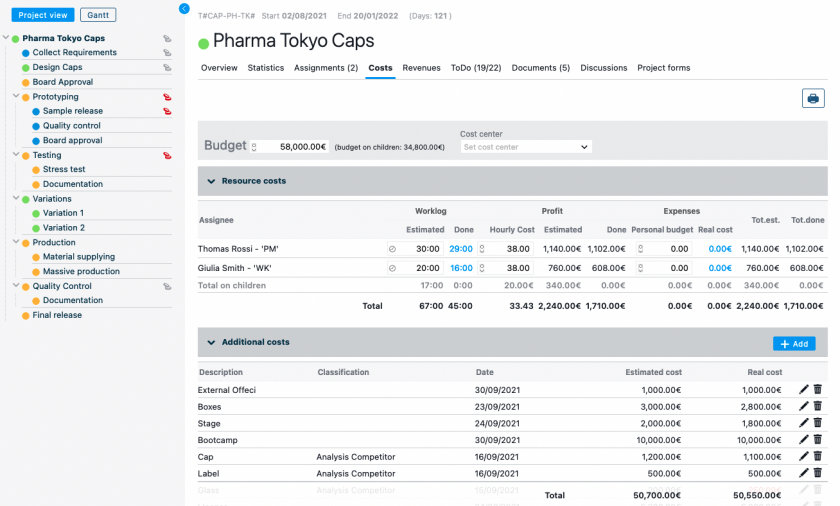How can I create a budget for a project if I have no historical basis on which to orient myself?
When starting a project, it is difficult to know how much it will cost.
If we are dealing with a repetitive project, we will probably have a history on which to base ourselves.
In this case it may be easier to draw up a project budget, but different is the case when it comes to a new project.
Project managers are required to account for their budget estimates.
Given the great uncertainty that usually prevails in the initial phase of a project, this can be one of the major challenges of a project manager.
The ability to create an accurate budget is an essential skill for a project manager.
It can be a daunting task, especially for new project managers; however, once the first budget is created, you will have a first reference system.
From then on, it will be easier to manage this aspect for future projects.
CONTENT INDEX
The approaches to drafting a budget
There are two main approaches that can be adopted when drawing up a budget:
- Top-down approach: decide how much the project will cost in total and divide the amount between the various phases of work;
- Bottom-up approach: calculate the individual work steps, starting from the lowest level, then adding sum up their cost and estimate the total cost of the project.
Both approaches, like all things, have their advantages and disadvantages.
Let’s try to evaluate them together.
How to make a project budget: The top-down approach
The top-down approach, literally from top to bottom, is more than simply a guess of the total amount on which to base the whole project.
In fact, it is necessary to explain how the work will be carried out and structured within the amount of budget allocated for each phase of the project.
One should ask oneself if the balance sheet seems realistic on the basis of the experience of past projects, if there are any.
The advantage of the top-down budgeting approach is that it focuses on achieving the project within the allocated budget and leads to efficiency and reduction of costly practices.
A disadvantage is that it presupposes that the person who creates the budget has sufficient knowledge and skills to make a reasonable cost estimate.
If this is not the case, a conflict may occur when a team member is assigned an unrealistic and insufficient budget to complete his work phase.
In fact, there is the risk that deliberately low budgets are created with the – false – belief that this will encourage cost savings and waste elimination.
How to make a project budget: the bottom-up approach
In the second approach, bottom-up, literally from bottom to top, the project budget is built starting from the individual work stages, from the lowest level, and adding them up until reaching the total cost of the project.
The team is often involved in identifying the tasks and activities needed to complete the project and to estimate the various costs.
The advantage of the bottom-up budgeting approach is its accuracy, assuming that we have not forgotten any activity, and consequently its cost.
It is good for team morale because the project manager involves the team in budgeting.
For this reason, this approach is sometimes called participatory budget.
A disadvantage of the bottom-up approach is the difficulty of obtaining a complete list of activities and tasks necessary to complete the project, especially if it is something new, or if we are dealing with a young and / or inexperienced team.
In fact, the risk in starting new projects or in the involvement of junior resources, may be that of not contemplating entire phases of activity and process.
This inevitably leads to totally unleashing not only the costs, but also the time required to complete the project.
The different types of cost in creating the budget
In creating the budget the Project Manager must take into account different factors and above all the different types of costs.
There are basically two types of costs that affect project managers when they create a budget:
- Direct costs
- And indirect costs.
The former are uniquely attributed to the project and can be easily definied, such as: the cost of personnel, equipment, travel, consultants, ecc.
Indirect costs, on the other hand, are related to expense items loaded simultaneously on more than one project. Only part of their total cost is charged to a single project.
For example: telephone bills, office rent, company insurance, office equipment, etc.
How to calculate these costs?
For example, if the project will take 6 weeks and the internet bill is € 50 per month, the total cost of the project will be € 75.
To get an idea of the other costs, you can take a look at the previous year.
It will be necessary to see what has been spent on the whole and then divide it by 52 (the number of weeks in the year) to obtain an average weekly cost.
This can be valid for an indirect cost such as that of the equipment.
How to make a project budget: the management reserve
A management reserve or contingency reserve is usually added to projects and usually corresponds to a percentage of the total cost and time of the project.
This fund is used when events related to unexpected costs occur during the project.
The management reserve should be adjusted according to the level of risk identified for the project.
Clearly, the more risky the project is, the greater the management reserve will have to be, and viceversa.
A routine project, already carried out several times, will have a lower management reserve than a totally new project.
The budget will therefore be made up of direct costs, indirect costs and the amount that serves as a management reserve.
How to make a project budget: ineligible costs
There are also costs that are generally not eligible in a project and therefore can not be included in the budget.
In general we can identify them in the following:
- Non-accountable costs, such as voluntary work;
- Capital investment costs;
- Financial charges;
- Passive interests;
- Losses caused by the currency exchange, among other things not quantifiable given the volatility;
- VAT in the case it is a recoverable cost;
- Costs covered by EU funding or by another type of state funding;
- Sanctions.
Manage budget changes
Projects rarely go according to plan in every detail.
It is therefore necessary that the project manager is able to identify when costs vary from budget and manage these changes.
A project manager must regularly compare the amount of money spent with the amount provided and report this information to the managers, the company president and the stakeholders.
It is therefore necessary to establish a method on how these progress will be measured and reported.
A widely used method for medium and high complexity projects is the earned value method.
This is a method of periodic comparison of the estimated costs – budget value – with the actual costs during the project – actual value.
The earned value method can provide information not only with regard to cost variances, but also with regard to time deviations, ie if the project is on time or not.
A simple way to evaluate the progress of the project is to take two values:
- Direct cost percentages pertaining to an activity;
- Sum of already worked hours on the activity and the forecast of the hours until the end of the project.
The progress of the activity will therefore result from the product between these two indicators. If it less than 1, it means that we are facing a project delay.
At the end of a project, it will be necessary to evaluate if a budget deviation has taken place and what were the reasons that caused it.
Regardless of the approach a project manager chooses to make the budget, it is essential to take the time to monitor it throughout the whole project.
In fact, for project management, cost monitoring is a strategic aspect.
For this reason in Twproject, we have developed the functionalities able to insert and manage both the costs generated by the work (direct costs) and the additional costs (indirect costs), reserving, of course, such access only to the Project Managers.

The importance of monitoring and managing a budget is crucial! Here is a small example of the support that TWproject can give you.

In this example (an integral part of the previous screen) your forecast margin (calculated from budget and planned costs) is 850.
This is the first estimate you’ve made, and it’s probably very close to what you told your client.
Then, in a second phase, you have refined your estimate: the second line represents how it is going in relation to what is planned.
The last line is the “real” situation, you have a budget of 2500, and you have spent 1285. Great! There is a margin of 1215, better than expected!
By streamlining internal project management via Twproject, Temera was able to implement a very strong and effective cost control on the resources directly involved in account-based projects, and to include and represent costs and resources from other services and systems in the same tool

Which is the best tool for making a project budget?
Therefore, building, customizing and monitoring the budget are fundamental aspects for a winning project!
Budget management is of the main tasks of the project manager, who also has many other activities to carry out during the project life cycle.
The support of a project management software can prove to be a very effective choice, not so much to eliminate the risk of cost overruns, but to help keep them under control.
A tool like Twproject is developed to meet the supervisory needs of the Project Manager and of those in the company who deal with cost management.
See how useful it is to use Twproject to manage your costs:
If you want to start testing the features of our software today, to create an accurate project budget, try the demo version: it’s free and complete with all the useful and necessary features.
What are the biggest difficulties you have experienced while creating a budget?
What strategy did you use?
Leave us a comment and share your experience with us.




